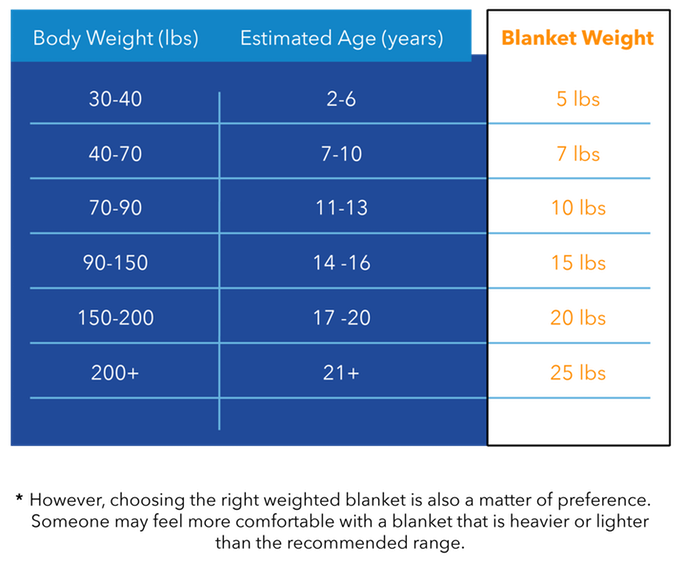Your Cart is Empty
Save up to 20% on all Harkla products & courses during Autism Acceptance Month! Click Here to See the Sale

Occupational Therapists know that light touch is alerting and can be overstimulating for people with sensory processing dysfunction.
The deep pressure provided by weighted blankets is intended to have a calming, organizing effect. Temple Grandin even created a “Squeeze Machine” based on her research of light versus deep touch.
Think of it as when you swaddle an infant. The firm, snug hug of the blanket wrapped around a sleeping infant helps the infant to relax enough to drift off to sleep. This sensation and its effect is mimicked with a weighted blanket and is the basis for weighted blanket therapy.

Individuals with autism or sensory processing dysfunction have difficulty with sensory modulation and regulation. This can manifest as an oversensitivity to sensory stimulation.
Weighted blankets are similar to weighted vests in that they offer proprioceptive or deep touch pressure (DTP) to the body. Since we know that proprioceptive, deep touch pressure helps to release serotonin, a neurotransmitter that helps to regulate some brain functions, weighted blankets are used to help with sensory modulation and regulation.
These sensory-based interventions that have a DTP component have been shown to have a calming, organizing effect on one’s nervous system.
In this article, we will look closely at the use of weighted blankets and how research supports the use of this intervention.
In a 2008 study published in Occupational Therapy in Mental Health, the use of a 30-lb weighted blanket resulted in adult participants reporting lower anxiety (63%), lower physiological data (blood pressure, pulse rate, pulse oximetry), and positive calming effects (78%). Weighted blanket use in mental health settings, proactively, and in crisis situations, had a calming effect that was reported to lower stress and provide a coping strategy in times of anxiety.
The use of weighted blankets has been expanded to include people with mental health diagnoses like post-traumatic stress disorder, ADHD, anxiety, and obsessive-compulsive disorder. Study participants reported feeling safe, calm, and grounded following weighted blanket use.
More recently, a 2011 study published in the Journal of Medical and Biological Engineering found the physiological effects of Deep Touch Pressure (medical data like heart rate, blood pressure, etc) corresponded with the participants’ reportedly lower anxiety levels following weighted blanket use. The study’s data validated a change in nervous system activity after deep touch pressure (weighted blanket) was introduced.
Since we know that people who experience sensory overstimulation experience real physiological symptoms, this study supports that deep touch pressure can help regulate those medical changes.
Another study found that weighted blankets could be a sleep aid for people who experience insomnia. Their research indicated that the participants’ sleep time increased, and movements during sleep decreased, with weighted blanket use. Subjective data in this study was overwhelmingly positive, with subjects reporting they enjoyed using the weighted blanket during sleep.
So, the research indicates potential positive effects of weighted blanket use for:
If you’re interested in learning more about using a weighted blanket, how to choose the right one, and what to do, read on!
When choosing a weighted blanket, it is important to consider two main features: weight and fabric.
A general guideline when deciding on your blanket’s weight factor is to multiply your child’s body weight by 10% and add 1-2 lbs. depending on preference. So a 50 lb child would be given a 5 lb weighted blanket on the low end and a 7 lb. blanket on the high end.
You want the weight to be heavy enough to provide deep touch pressure, but not so heavy that it poses a safety risk during sleep. The type of weight and style of the blanket will differ on how the weight is distributed, and the design may impact washability, so take a close look at how the blanket is weighted.

The style of fabric you choose will depend on a couple of factors. Your child’s sensory preferences are important, so don’t be afraid to consider texture, color, and pattern!
There are a variety of weighted blanket fabrics to meet your child’s interests, no matter how specific or idiosyncratic they may be. The blanket should be a positive experience, so choose one that will entice your child.
You will also want to consider how easy the blanket is to care for. Some weighted blankets, like Harkla’s weighted blankets, have removable covers that make them easy to wash and dry.
Now that you’ve chosen the weight and style of your blanket, how do you use it?

Weighted blankets can be used on top of a child lying down or draped over them when sitting/standing. Every child has different sensory needs and preferences, so let your child find the way that works the best for him/her.
Wrap them in the blanket like a burrito, drape it over their shoulders, lay it flat on top of them when they’re laying in bed for the night. Whenever, however, wherever your child needs the deep touch pressure input, the weighted blanket can be used to meet his needs.
Because sensory-based interventions, like the use of weighted blankets, differ in the observable effects for each person, it is important to note any changes that may occur after introducing a weighted blanket.
You can feel confident in trying a weighted blanket, knowing that it offers the possibility of self-regulation assistance with virtually no side effects, unlike some medical interventions.
If you have questions about choosing the right weighted blanket for your child or have feedback to offer after trying one out, we’d love to hear from you!
Thanks for this article. I’m a fellow OT in Ohio. I very much appreciate it.
Comments will be approved before showing up.



Nicole
March 19, 2019
Hi Molly,
Thanks for your feedback! We really appreciate it.
Take care,
Nicole
Harkla Happiness NInja